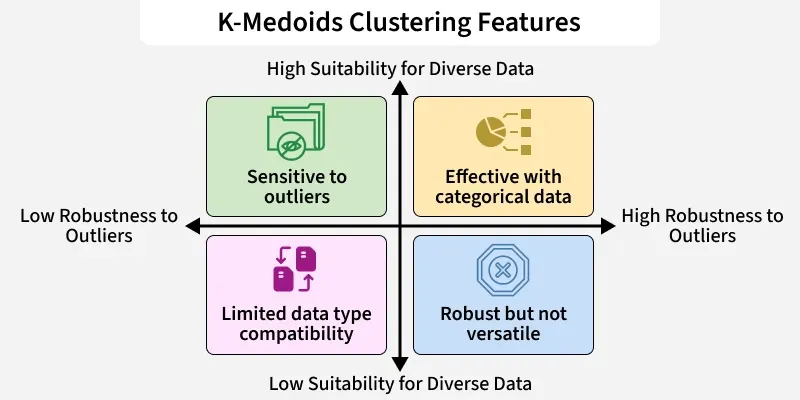K-Medoids clustering in Machine Learning
Last Updated :
13 Nov, 2025
K-Medoids, also known as Partitioning Around Medoids (PAM), is a clustering algorithm introduced by Kaufman and Rousseeuw. It is similar to K-Means, but instead of using the mean of points as a cluster center, it uses an actual data point called a medoid.
 K-Medoids clustering in Machine Learning
K-Medoids clustering in Machine LearningWhat is a Medoid?
A medoid is the most centrally located data point within a cluster. It minimizes the total dissimilarity with all other points in that cluster. The dissimilarity between a medoid Ci and an object Pi is given by: E = |P_i - C_i|
The total cost (or objective function) of K-Medoids is defined as:
c = \sum_{C_i} \sum_{P_i \in C_i} |P_i - C_i|
K-Medoids Algorithm Steps
1. Initialize: Randomly select k data points from the dataset as initial medoids.
2. Assign Points: Assign each data point to the nearest medoid using a distance metric (e.g., Manhattan or Euclidean).
3. Update Step (Swap): For each medoid m, try swapping it with a non-medoid point ooo.
- Recalculate the cost for this new configuration.
- If the total cost decreases, accept the swap; otherwise, revert.
4. Repeat: Continue until no further cost reduction is possible.
Solved Example
Let’s consider the following example.
 Example
ExampleIf a graph is drawn using the above data points, we obtain the following:
 Graph
GraphStep 1: Initialization
Let the randomly selected 2 medoids be: k=2 and let C1 = (4, 5) and C2 = (8, 5).
Step 2: Calculating cost
The dissimilarity of each non-medoid point with the medoids is calculated and tabulated:
 Calculating cost
Calculating costWe use the Manhattan distance formula to calculate the distance between medoid and non-medoid points:
\text{Distance} = |X_1 - X_2| + |Y_1 - Y_2|
Each point is assigned to the cluster of the medoid whose dissimilarity is lesser.
- Points 1, 2 and 5 -> Cluster C1
- Points 0, 3, 6, 7 and 8 -> Cluster C2
Cost = ( 3+ 4+ 4) +( 3+ 1+ 1+ 2+ 2) = 20
Step 3: Swap and Recalculate
Now, randomly select one non-medoid point and recalculate the cost. Let the randomly selected point be (8, 4).
 Swap and Recalculate
Swap and RecalculateEach point is assigned to the cluster whose dissimilarity is lesser.
- Points 1, 2 and 5 -> Cluster C1
- Points 0, 3, 6, 7 and 8 -> Cluster C2
New Cost = ( 3+ 4+ 4) +( 2+ 2+ 1+ 3+ 3) = 22
Swap Cost = New Cost - Previous Cost = 22-20 = 2
Since 2 >0, the swap cost is not less than zero, so we undo the swap.
Hence, (4, 5) and (8, 5) are the final medoids.
 Final
FinalFinal Result
The clustering is as follows:
- Cluster 1: (4, 5) -> Points 1, 2, 5
- Cluster 2: (8, 5) -> Points 0, 3, 6, 7, 8
The time complexity of the K-Medoids algorithm is: O(k \times (n - k)^2)
Advantages
- It is simple to understand and easy to implement.
- K-Medoids converges in a fixed number of steps.
- It is less sensitive to outliers compared to other partitioning algorithms.
Disadvantages
- Not suitable for non-spherical or arbitrarily shaped clusters.
- Results may differ across runs due to random initialization of medoids.
Explore
Machine Learning Basics
Python for Machine Learning
Feature Engineering
Supervised Learning
Unsupervised Learning
Model Evaluation and Tuning
Advanced Techniques
Machine Learning Practice